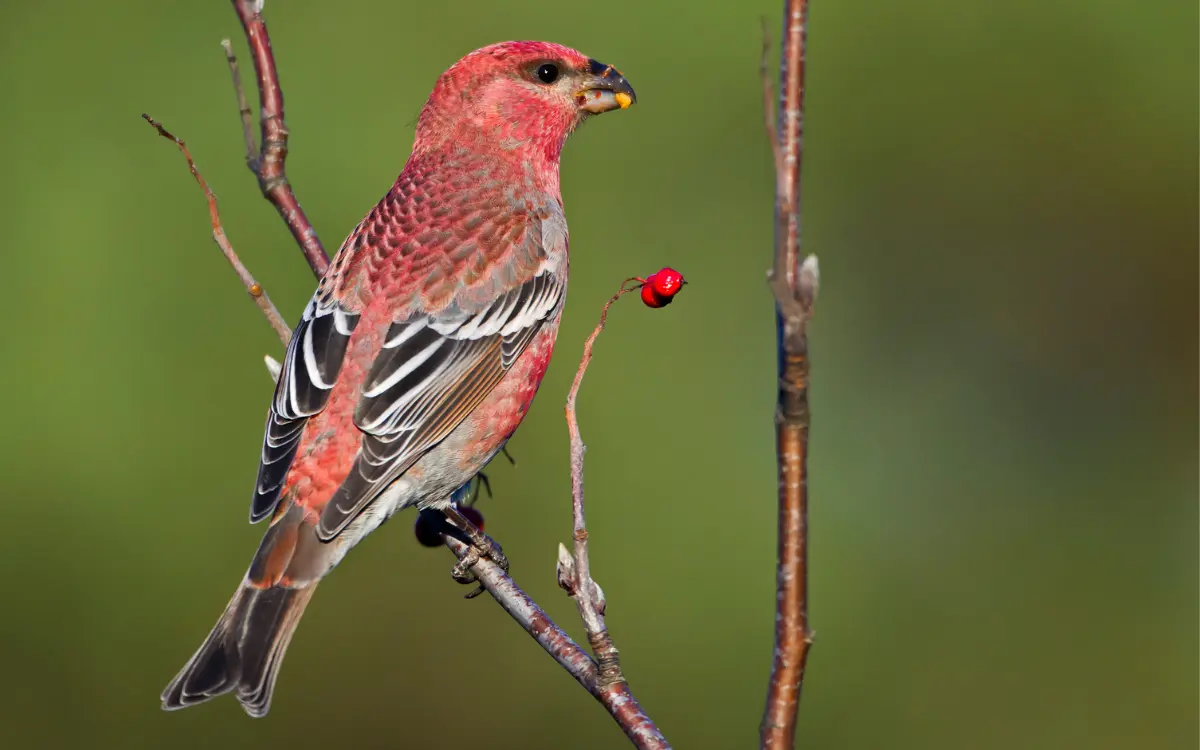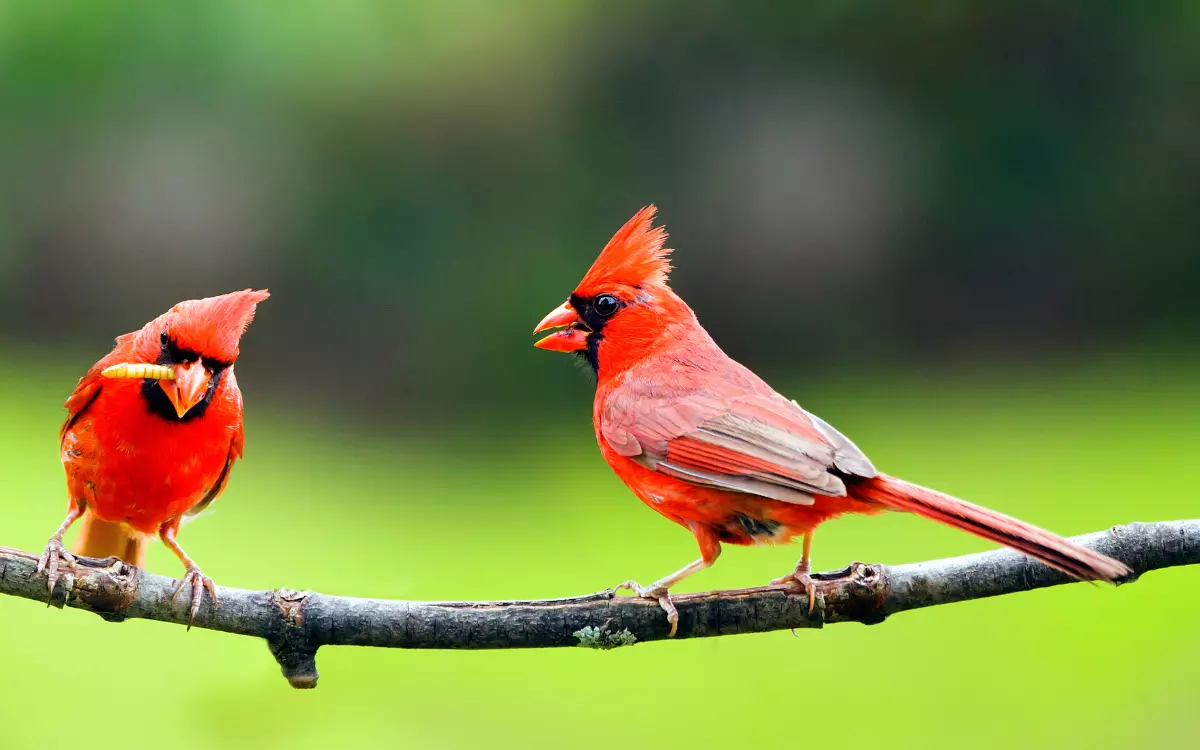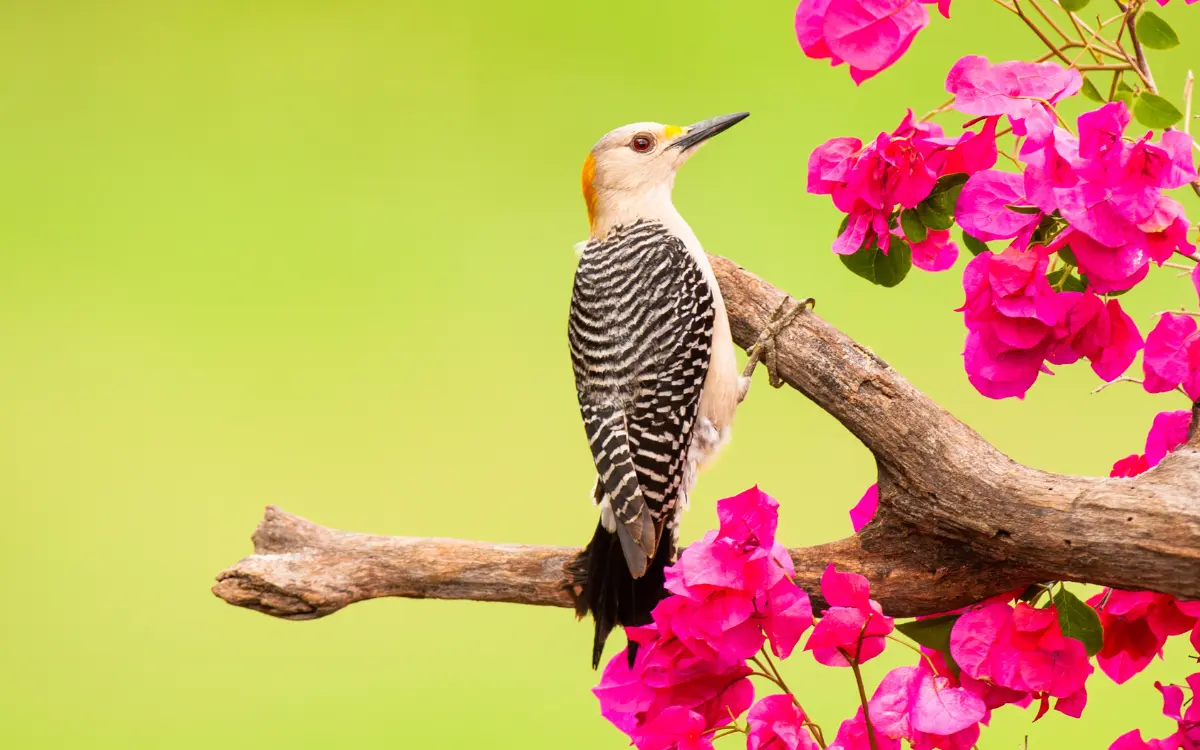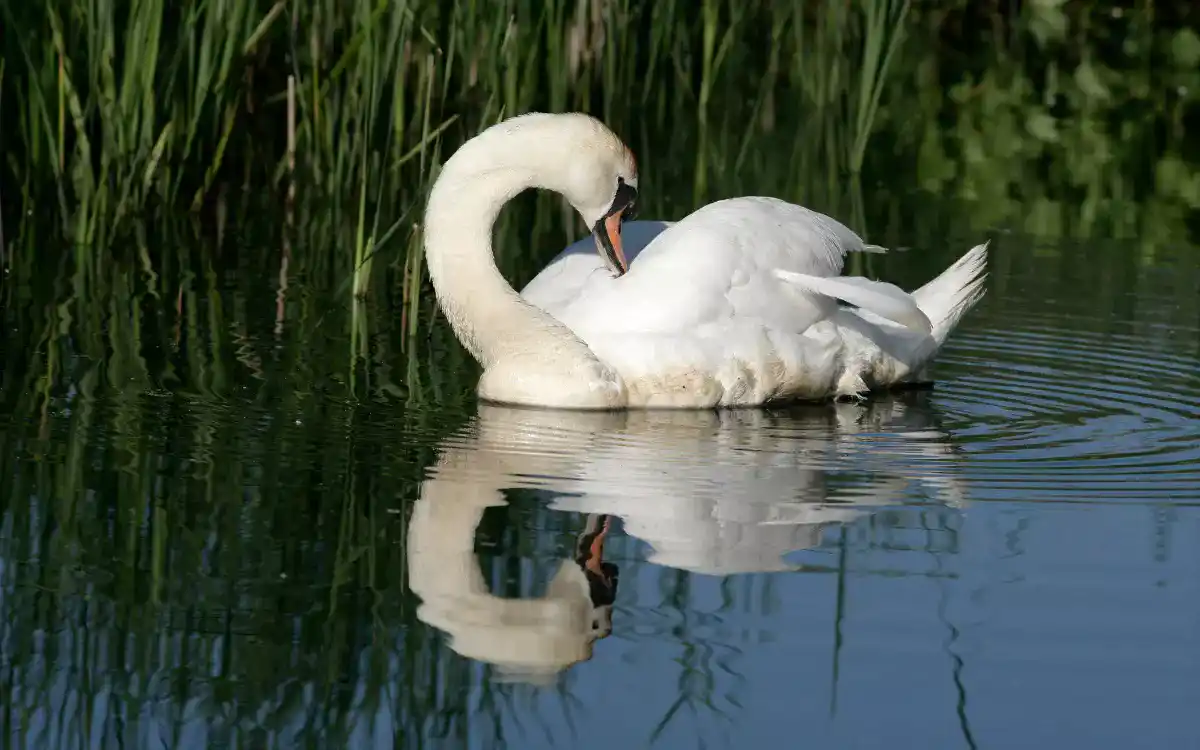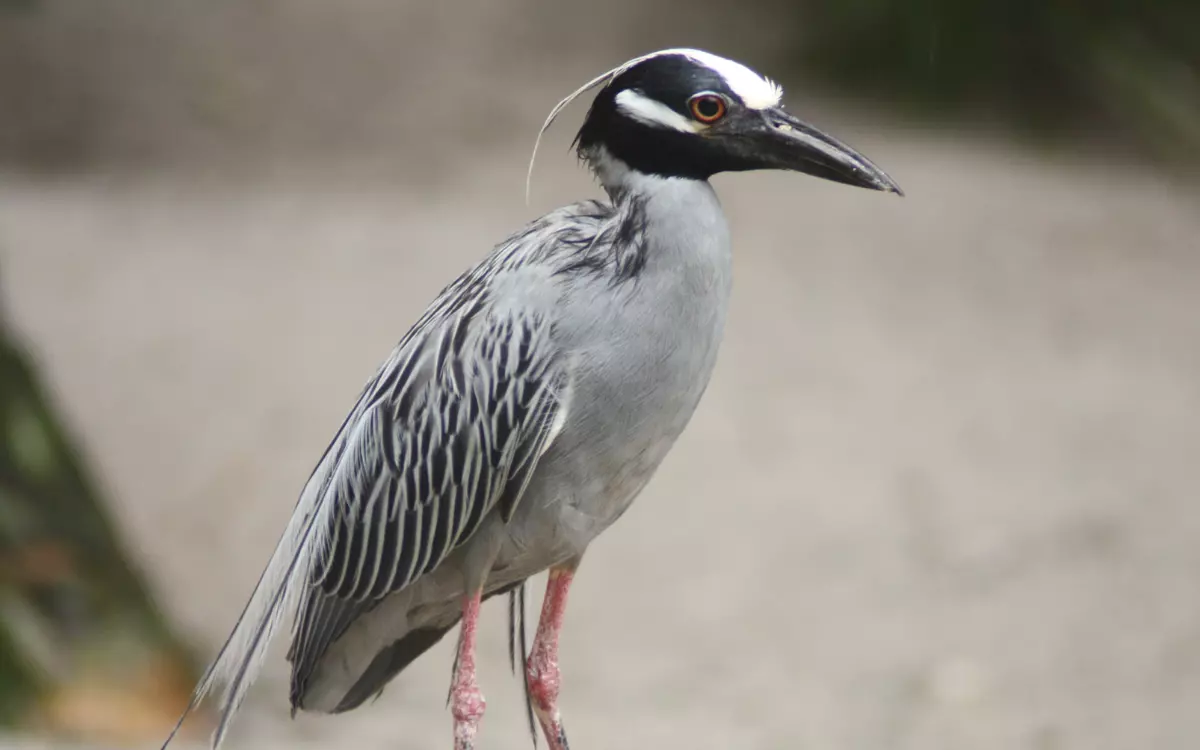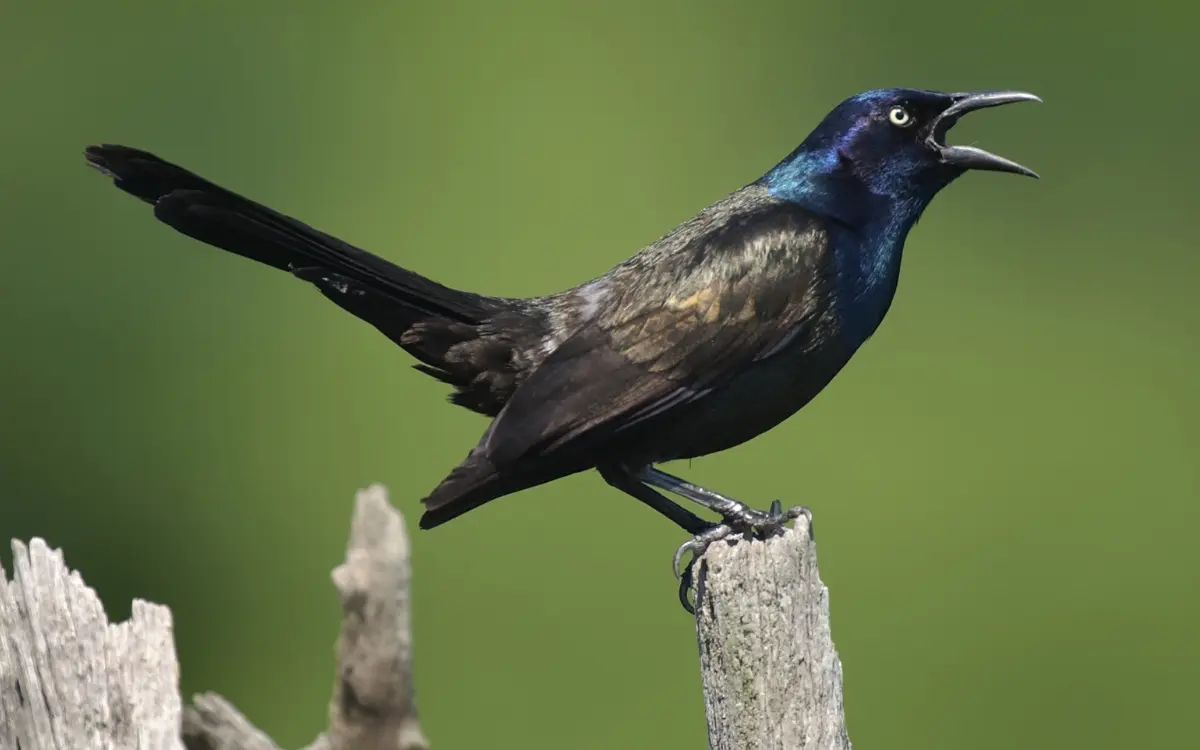9 Wrens In Texas That look like Wonderful
Found the diverse world of wrens in Texas, where these small but mighty birds thrive in various habitats, showcasing their unique behaviors and melodious songs.
All Wren birds list found in Texas:
- Cactus Wren (Campylorhynchus brunneicapillus)
- Carolina Wren (Thryothorus ludovicianus)
- Bewick’s Wren (Thryomanes bewickii)
- House Wren (Troglodytes aedon)
- Sedge Wren (Cistothorus platensis)
- Marsh Wren (Cistothorus palustris)
- Rock Wren (Salpinctes obsoletus)
- Canyon Wren (Catherpes mexicanus)
- Winter Wren (Troglodytes hiemalis)
1.Carolina Wren (Thryothorus ludovicianus):
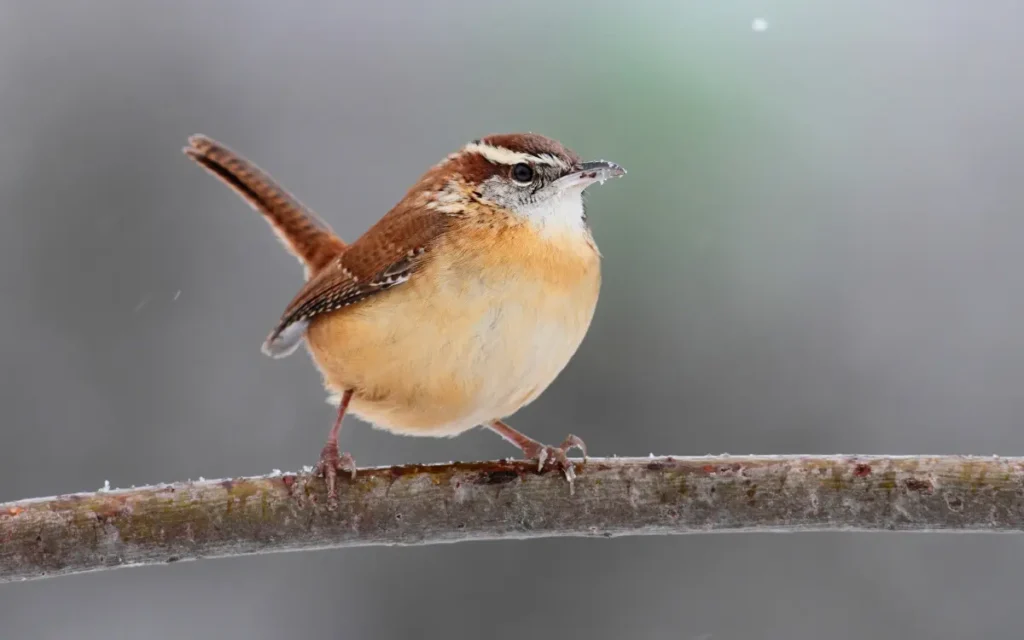
The Carolina Wren is a small, stout bird with a round body and a long tail. They have a rich brown upper body, a warm orange-brown belly, and a white throat. A distinctive white stripe runs above each eye.
- Habitat and Distribution: In Georgia, Carolina Wrens are found in various habitats, including forests, gardens, and urban areas. They prefer dense vegetation where they can easily hide and build nests.
- Diet: These wrens mainly eat insects and spiders. They forage for food in leaf litter, on tree trunks, and in bushes.
- Nesting: Carolina Wrens are monogamous and often pair for life. They build nests in secluded spots like tree cavities, shrubs, or even in man-made structures.
- Vocalizations: Known for their loud and melodious song that sounds like “teakettle-teakettle-teakettle.” They are one of the most vocal birds, especially in the morning.
- Conservation: Currently, Carolina Wrens are not considered threatened. However, they can be affected by severe cold weather and habitat destruction.
- Attracting Tips: To attract Carolina Wrens to your backyard, provide dense shrubbery for shelter, offer suet feeders, and install nesting boxes with small entrance holes.
2. House Wren (Troglodytes aedon):
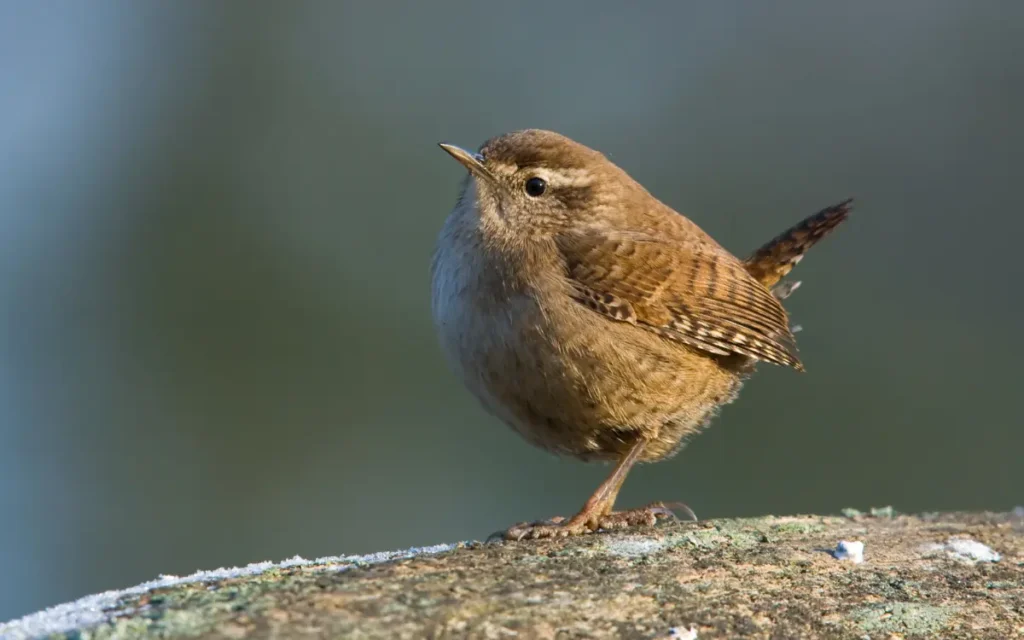
House Wrens are small, brown birds with a short tail and thin bill. They have dark barring on their wings and tails.
- Habitat: Common in Georgia, seen in backyards, parks, and woods.
- Diet: Eats insects, spiders, and other small invertebrates.
- Nesting: Builds nests in odd places like boots, cans, or boxes. They use nest boxes with small entrance holes.
- Vocalizations: Known for their beautiful, energetic song with rapid chatters and rattles.
- Interaction with Humans: Often found nesting in unusual places in human habitats.
- Conservation: Not currently threatened, but habitat loss can be a concern.
3.Winter Wren (Troglodytes hiemalis):
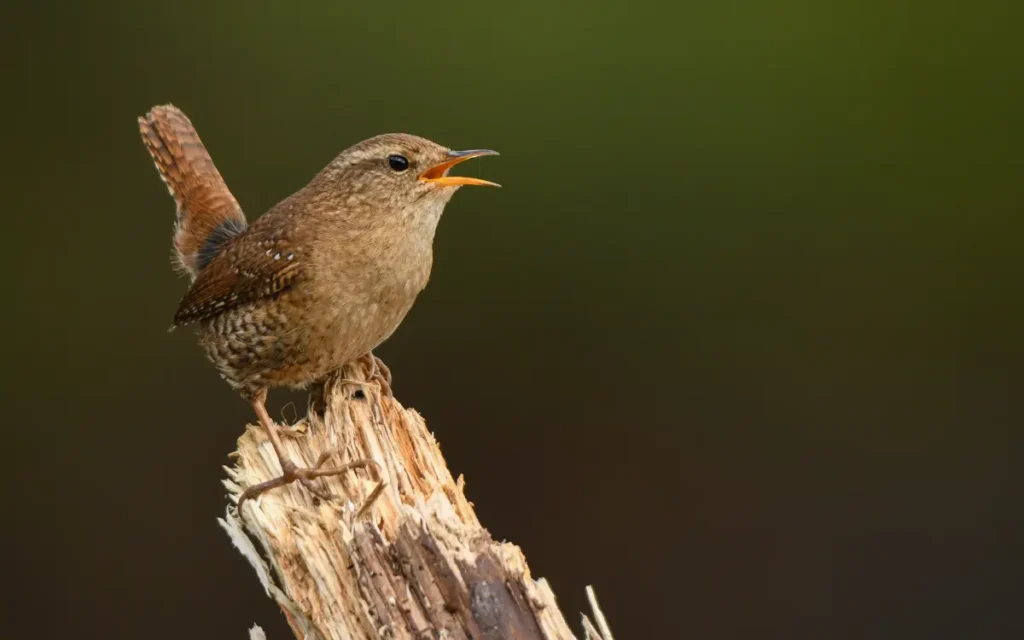
Winter Wrens are small, plump birds with a short tails that they often hold upright. They have a brown back with darker bars and a lighter brown belly. They are about 3 to 4 inches long.
- Habitat and Distribution in Georgia: In Georgia, Winter Wrens are mainly found during the winter months. They prefer dense forests with lots of underbrush.
- Diet and Foraging Behavior: These wrens eat insects and spiders. They forage on the forest floor, flipping over leaves and debris to find their prey.
- Nesting Habits and Reproduction: Winter Wrens nest in the northern part of their range. They build their nests in hidden spots, like tree roots or rock crevices.
- Vocalizations and Songs: Winter Wrens have a beautiful, long, and complex song that can last up to 10 seconds. It’s a series of musical trills and chatters.
- Conservation Status and Threats: Winter Wrens are not currently considered threatened, but habitat destruction could become a concern in the future.
4.Marsh Wren (Cistothorus palustris):
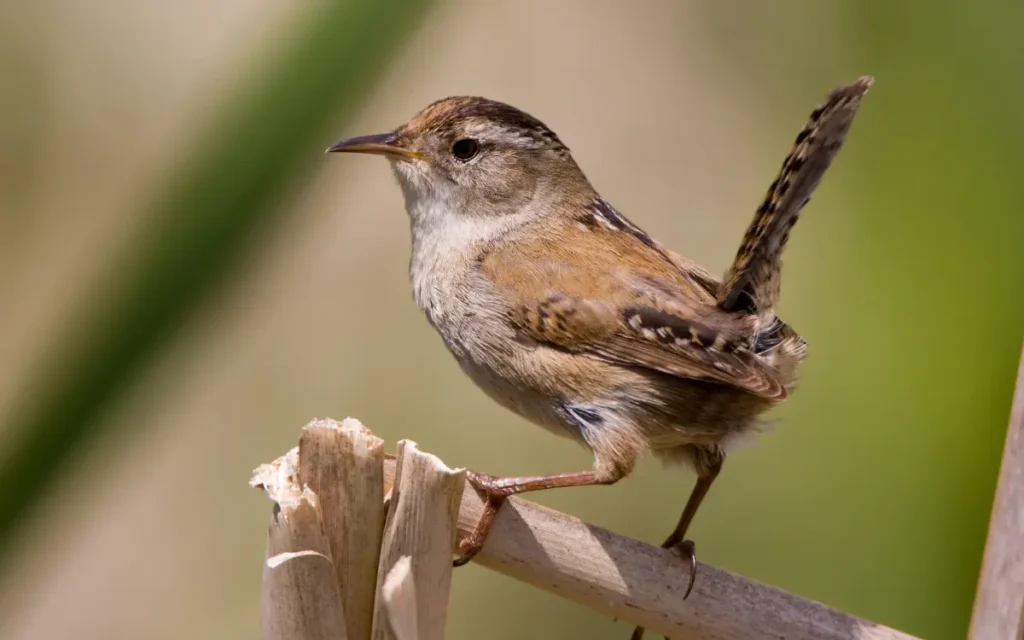
Marsh Wrens are small birds with brown backs, black and white streaks, and a pale brown underside. They have a distinctive upright tail and a longer bill compared to other wrens. They are about 4 to 5 inches long.
- Habitat and Distribution in Georgia: In Georgia, Marsh Wrens are found in wetlands, particularly in marshes with tall reeds and cattails.
- Diet and Foraging Behavior: These wrens eat insects and spiders, and they pick off leaves close to the water. They are often seen clinging to reeds while foraging.
- Nesting Habits and Reproduction: Marsh Wrens build their nests in tall reeds, creating a fully enclosed structure with a small opening at the top. They lay 3 to 10 eggs per clutch.
- Vocalizations and Songs: Marsh Wrens has a distinctive buzzy song that can last for up to 20 minutes. They are most vocal at dawn and dusk.
- Aggressive Behavior: Marsh Wrens are known for their aggressive behavior, especially during the breeding season. They may build multiple dummy nests and are known to destroy the eggs and nestlings of rival birds.
- Conservation Status and Threats: Marsh Wrens are not currently considered threatened, but habitat loss and degradation pose potential risks to their populations.
5. Sedge Wren (Cistothorus platensis):
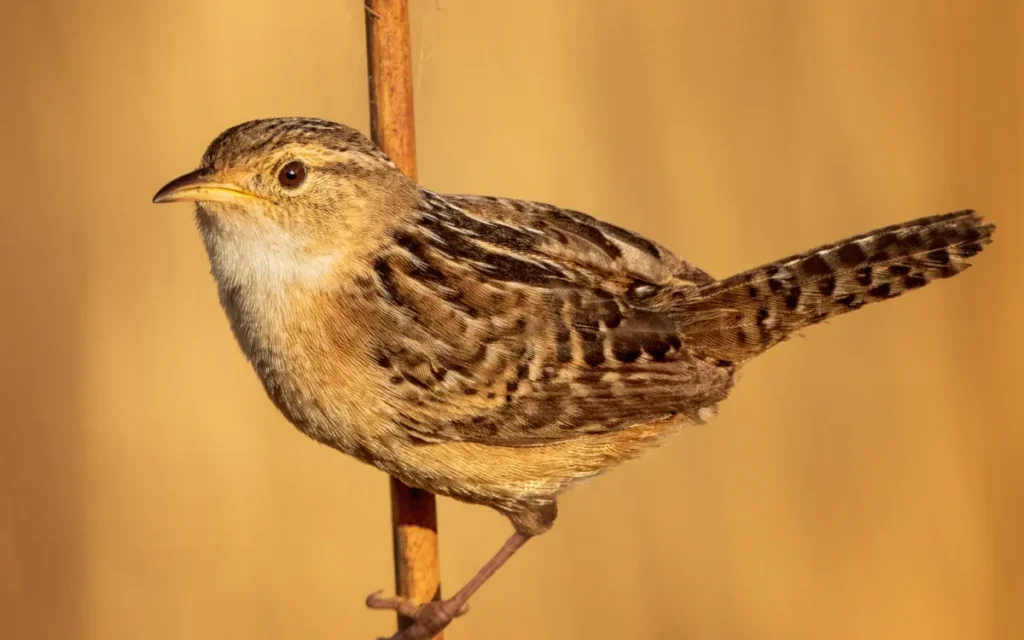
Sedge Wrens are small birds with brown upperparts and white underparts. They have a light brown cap and a white stripe above the eye. They are about 4 to 5 inches long.
- Habitat and Distribution in Georgia: In Georgia, Sedge Wrens are seen during migration, especially from October to December. They prefer wet grasslands, marshy areas, and meadows.
- Diet and Foraging Behavior: These wrens eat insects and spiders. They forage in dense vegetation, often near water.
- Nesting Habits and Reproduction: Sedge Wrens breed in the northern part of their range. They build their nests close to the ground in dense vegetation.
- Vocalizations and Songs: Their song consists of a series of short notes followed by rapid trills. They are more often heard than seen.
- Nomadic Nature: Sedge Wrens are known for their nomadic behavior, often moving from one place to another, which makes them challenging to spot.
- Conservation Status and Threats: Sedge Wrens are not currently considered threatened, but their populations can be affected by habitat loss and degradation.
Sedge Wrens are elusive birds with a distinctive song and nomadic nature. Protecting their preferred wetland habitats is essential for their conservation during their migration through Georgia.
6.Cactus Wren (Campylorhynchus brunneicapillus):
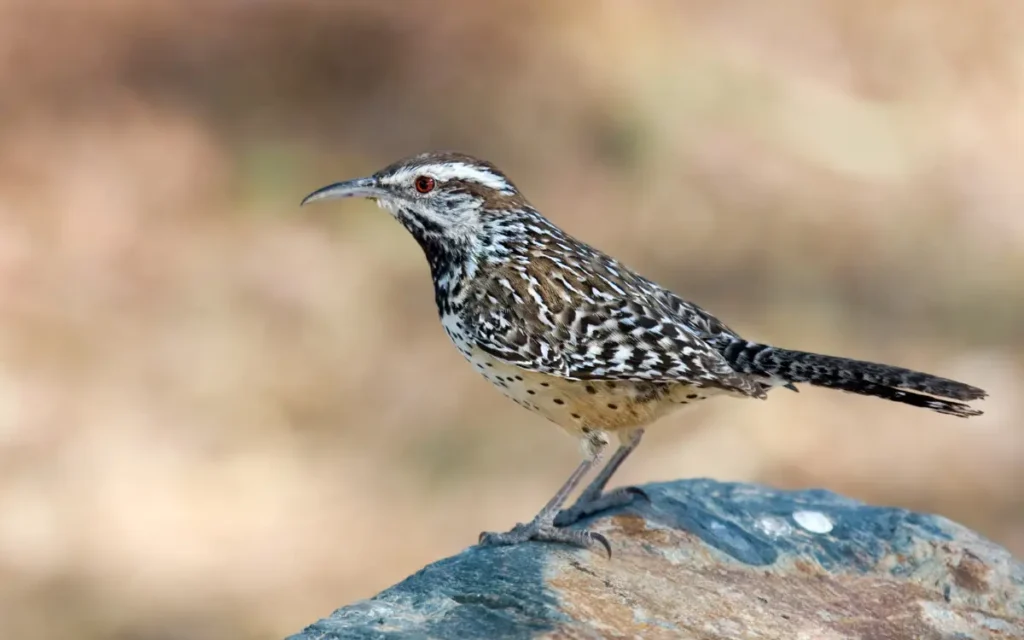
The Cactus Wren is the largest wren in the United States. It has a brown back with white spots, a white belly with black spots, and a long, curved beak. The tail is long and often held upright. They are about 7 to 9 inches long.
- Habitat and Distribution: Cactus Wrens are primarily found in the southwestern United States and Mexico. In Georgia, they are not common and are mostly seen in areas with cactus and other desert-like vegetation.
- Diet and Foraging Behavior: They eat insects, spiders, and some fruits and seeds. Cactus Wrens forage on the ground and in vegetation, often in pairs or small groups.
- Nesting Habits and Reproduction: These wrens build large, dome-shaped nests in cactus plants or thorny shrubs. The female lays 3 to 6 eggs, which are incubated for about two weeks.
- Vocalizations and Songs: The Cactus Wren has a distinctive, harsh call that sounds like a car engine starting. Their song is a series of loud, chattering notes.
- Conservation Status and Threats: Cactus Wrens are not currently considered threatened, but habitat loss due to urbanization and agriculture is a concern.
The Cactus Wren is a fascinating bird adapted to life in arid environments. Protecting their desert habitats is crucial for their continued survival.
7. Bewick’s Wren (Thryomanes bewickii):
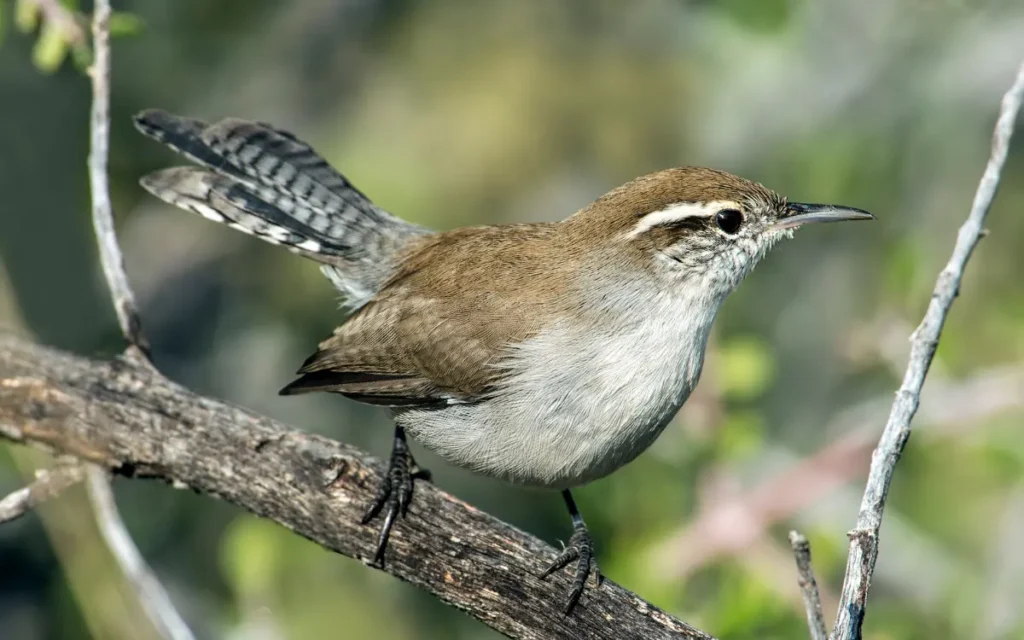
Bewick’s Wren is a small bird with a long, slender body and a tail that is often held upright. It has a brown back, grayish-white underparts, and a long, slightly curved beak. They have a white stripe over the eye. They are about 5 to 6 inches long.
- Habitat and Distribution: In Georgia, Bewick’s Wrens are found in open woodlands, scrublands, and suburban areas. They prefer habitats with dense vegetation for cover.
- Diet and Foraging Behavior: They eat insects, spiders, and other small invertebrates. Bewick’s Wrens forage on the ground and in bushes, often flipping leaves and twigs to find food.
- Nesting Habits and Reproduction: These wrens build nests in cavities, such as tree holes, rock crevices, or even in man-made structures. The female lays 5 to 7 eggs, which are incubated for about two weeks.
- Vocalizations and Songs: Bewick’s Wren has a loud, melodious song with a series of clear, whistled notes. They are also known for their scolding calls when disturbed.
- Conservation Status and Threats: Bewick’s Wrens are not currently considered threatened, but habitat loss and competition with other bird species can impact their populations.
Bewick’s Wrens are charming birds with a beautiful song and active foraging behavior. Preserving their natural habitats and providing nesting sites can help ensure their presence in Georgia’s landscape.
8.Rock Wren (Salpinctes obsoletus)

Rock Wrens are small, grayish-brown birds with a white belly and faint streaks on the breast. They have a long, slightly curved beak and a short tail. They are about 5 to 6 inches long.
- Habitat and Distribution: Rock Wrens are typically found in rocky areas, such as cliffs, canyons, and outcroppings. They are not common in Georgia but are more prevalent in the western United States.
- Diet and Foraging Behavior: These wrens primarily eat insects and spiders. They forage among rocks and crevices, often hopping and darting around to catch their prey.
- Nesting Habits and Reproduction: Rock Wrens build their nests in rock crevices or under boulders. The female lays 4 to 6 eggs, which are incubated for about two weeks.
- Vocalizations and Songs: The song of the Rock Wren is a series of clear, melodious notes and trills. They are known for their loud and persistent singing.
- Conservation Status and Threats: Rock Wrens are not currently considered threatened, but their populations could be impacted by habitat destruction and climate change.
Rock Wrens are fascinating birds adapted to life in rocky environments. Protecting their natural habitats is crucial for their continued survival.
9. Canyon Wren (Catherpes mexicanus):
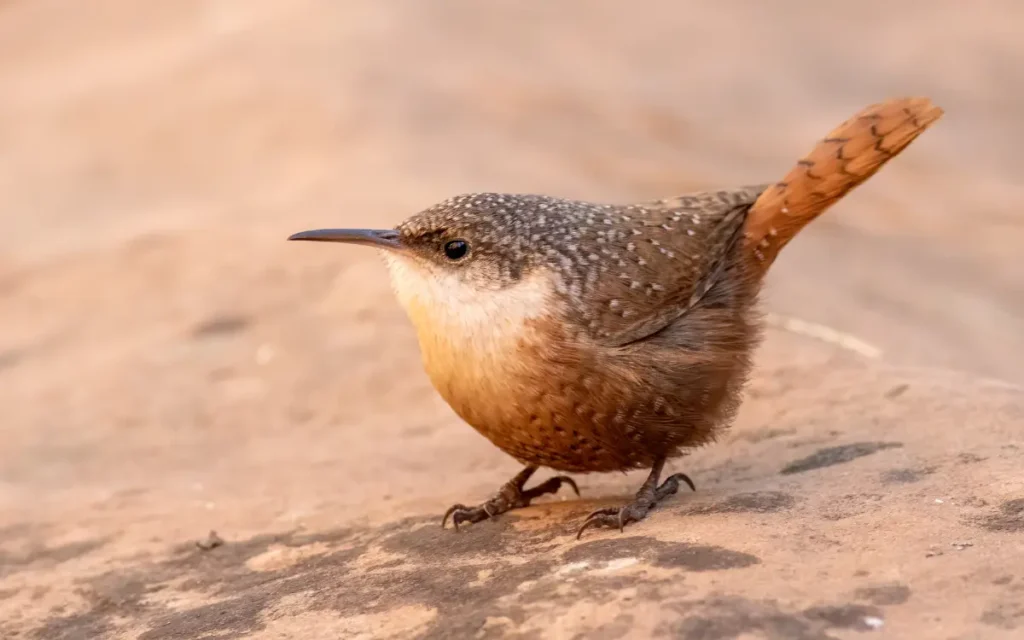
Canyon Wrens are small birds with a distinctive long, slender bill and a white throat with a reddish-brown body. They have a long, white eyebrow stripe and a tail with dark bars. They are about 5 to 6 inches long.
- Habitat and Distribution: These wrens are found in rocky canyons, cliffs, and outcrops in the western United States and Mexico. In Georgia, they are not common and are mostly seen in areas with similar rocky habitats.
- Diet and Foraging Behavior: Canyon Wrens primarily eat insects and spiders. They forage by hopping and climbing on rocks and cliffs, often turning over stones to find their prey.
- Nesting Habits and Reproduction: They build their nests in crevices or under overhangs in rocky cliffs. The female lays 4 to 6 eggs, which are incubated for about two weeks.
- Vocalizations and Songs: Canyon Wrens are known for their beautiful, descending, melodic song that echoes through their rocky habitats.
- Conservation Status and Threats: Canyon Wrens are not currently considered threatened, but habitat destruction and disturbance can pose risks to their populations.
Canyon Wrens are charming birds with a unique appearance and hauntingly beautiful songs. Protecting their rocky habitats is essential for their continued survival.
Related article:
- 21 Types of Wren Birds
- 41 Species of Ducks Found in Texas (Identification, Calls)
- 8 Texas Bird Yellow Belly With Their Beauty
FAQs:
Q: What wrens live in Texas?
Ans: In Texas, you can find Carolina Wrens, Bewick’s Wrens, Canyon Wrens, Cactus Wrens, Rock Wrens, House Wrens, Marsh Wrens, Sedge Wrens, and Winter Wrens.
Q: Are there wrens in America?
Ans: Yes, there are wrens in America. The continent is home to several species, including the House Wren, Carolina Wren, and Bewick’s Wren, among others.
Q: Are wrens smart birds?
Ans: Wrens are considered intelligent birds, especially in their ability to adapt to different environments and find food.
Q: What is the largest wren in the United States?
Ans: The largest wren in the United States is the Cactus Wren, which can reach lengths of 7 to 9 inches.
Q: What are wrens famous for?
Ans: Wrens are famous for their loud and melodious songs, despite their small size. They are also known for their energetic behavior and adaptability to various habitats.
Q: Why are wrens called the King of the birds?
Ans: The title “King of the Birds” comes from a fable in which birds held a contest to see who could fly the highest. The wren hid on the eagle’s back and flew higher than the eagle at the last moment, claiming the title. This story is a metaphor for the wren’s cleverness and resourcefulness.
Conclusion:
Texas is home to a variety of wren species, each with its own unique charm. From the Texas bird yellow belly of the Carolina Wren to the rugged habitat of the Rock Wren, these small birds contribute significantly to the state’s rich birdlife. Understanding and appreciating the diversity of wrens in Texas can enhance our birdwatching experiences and support conservation efforts.

